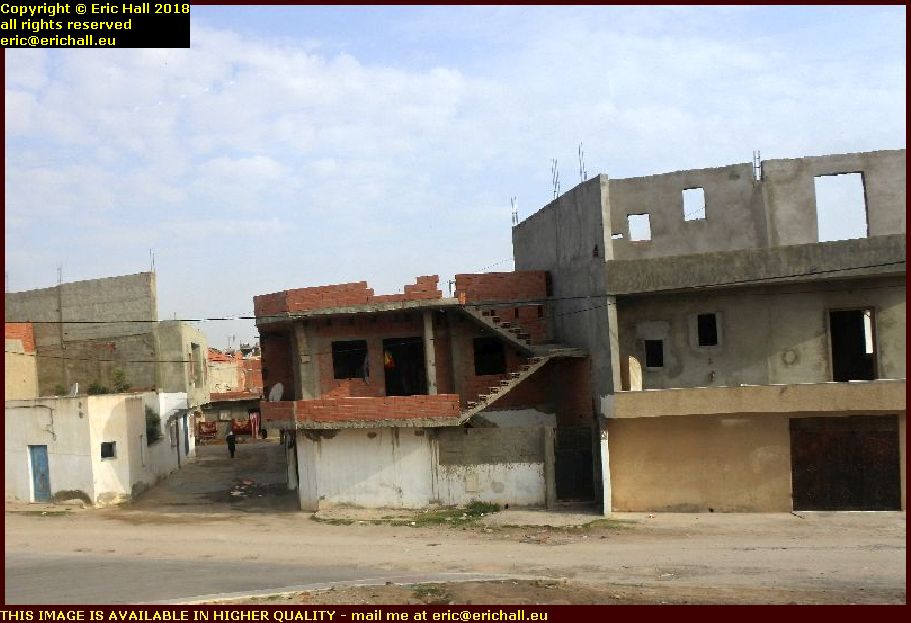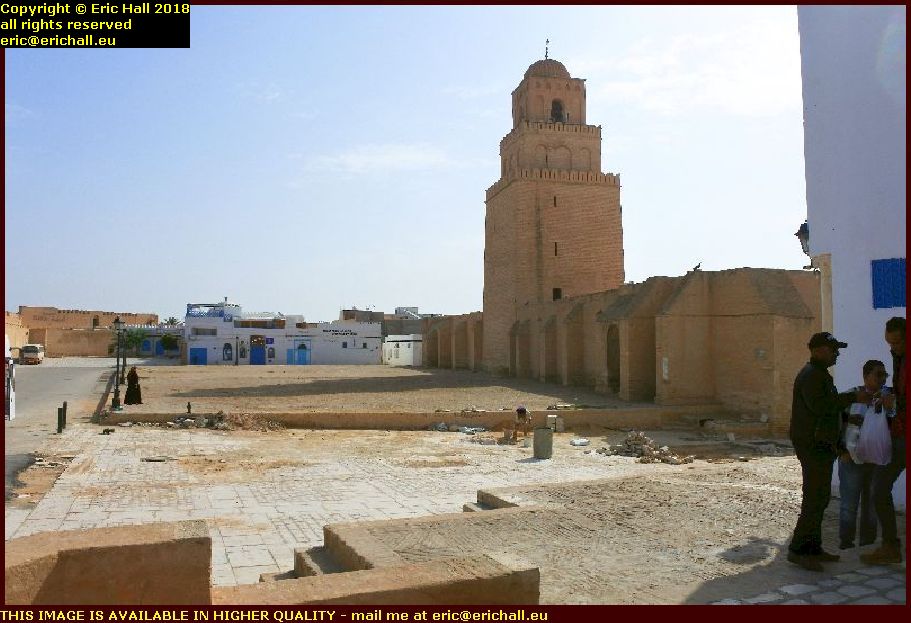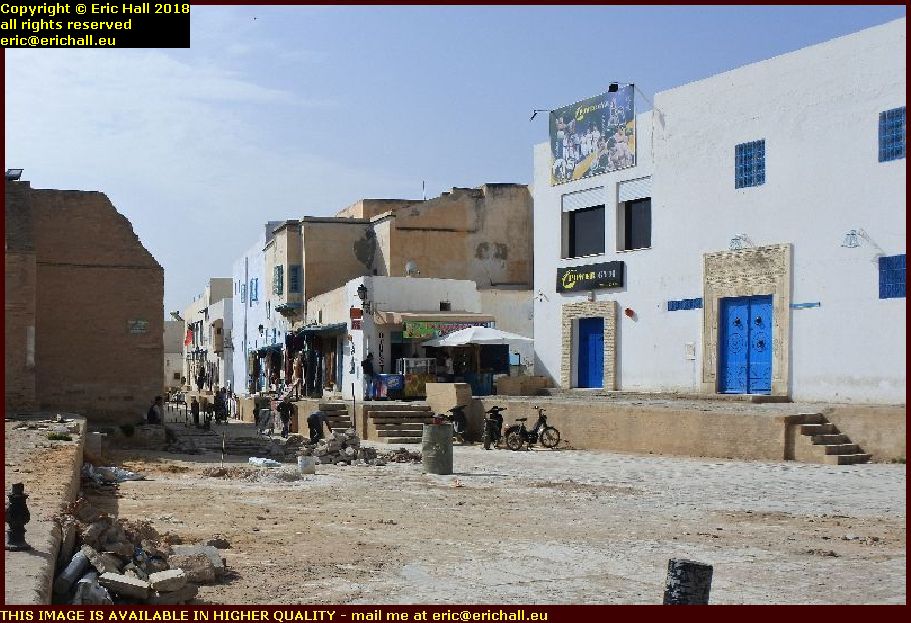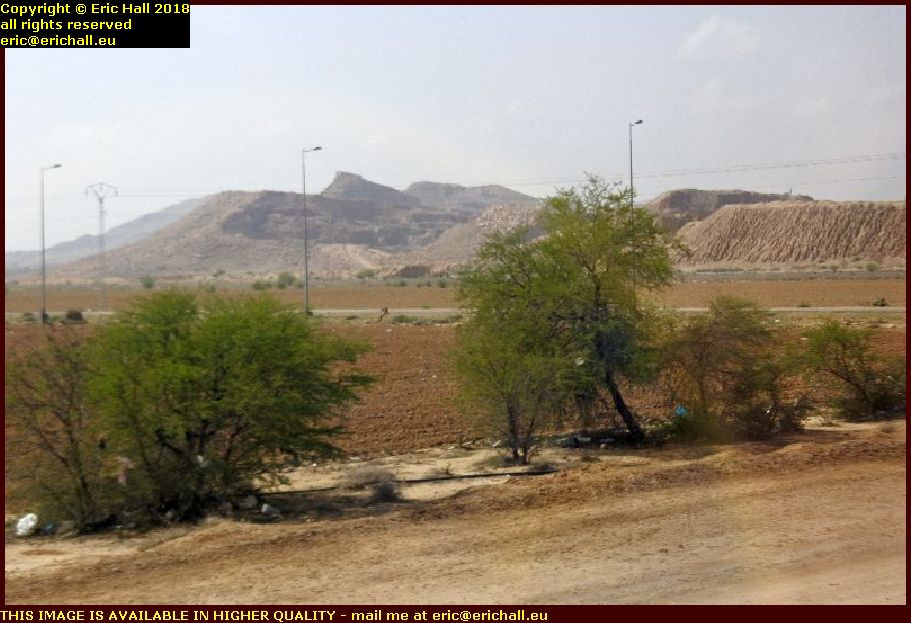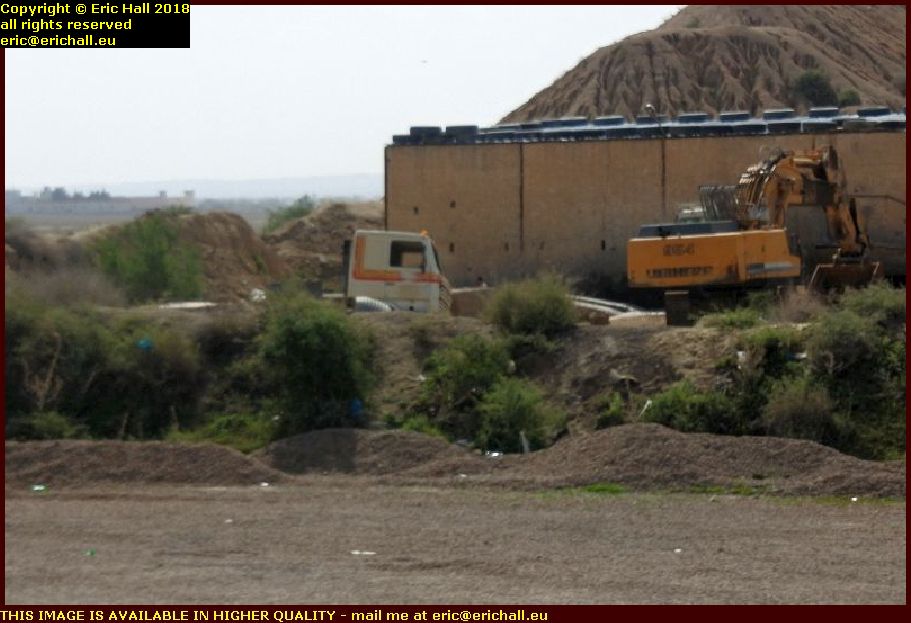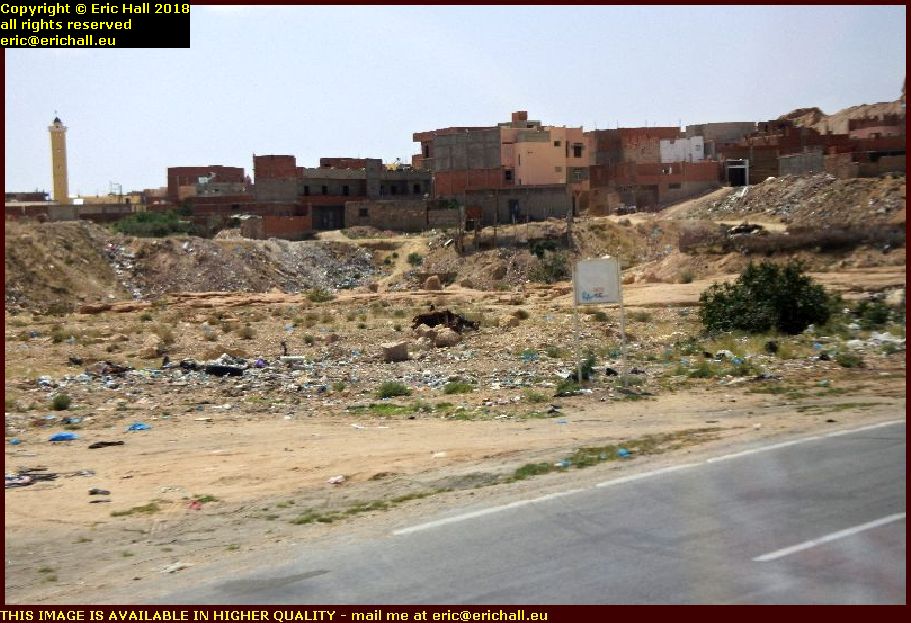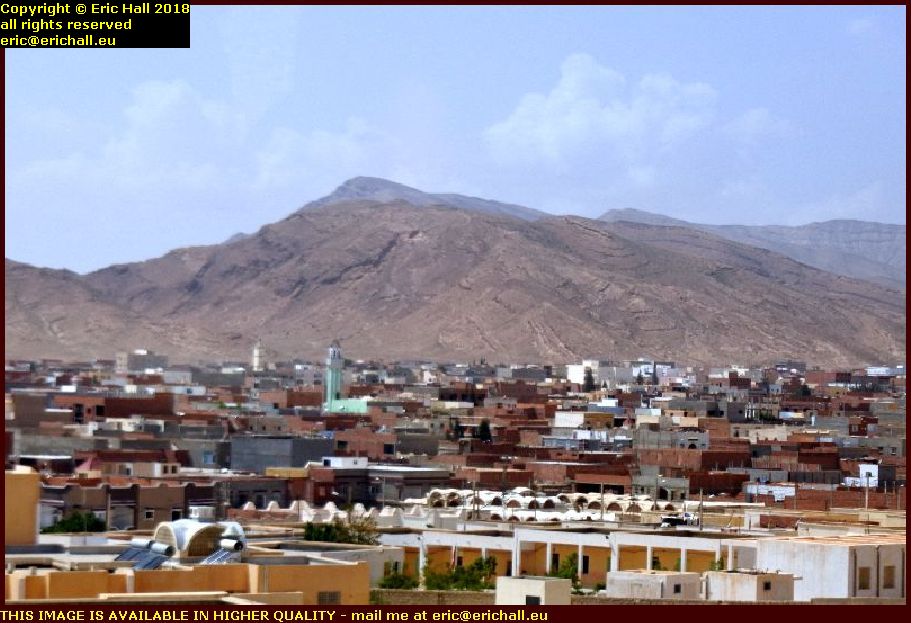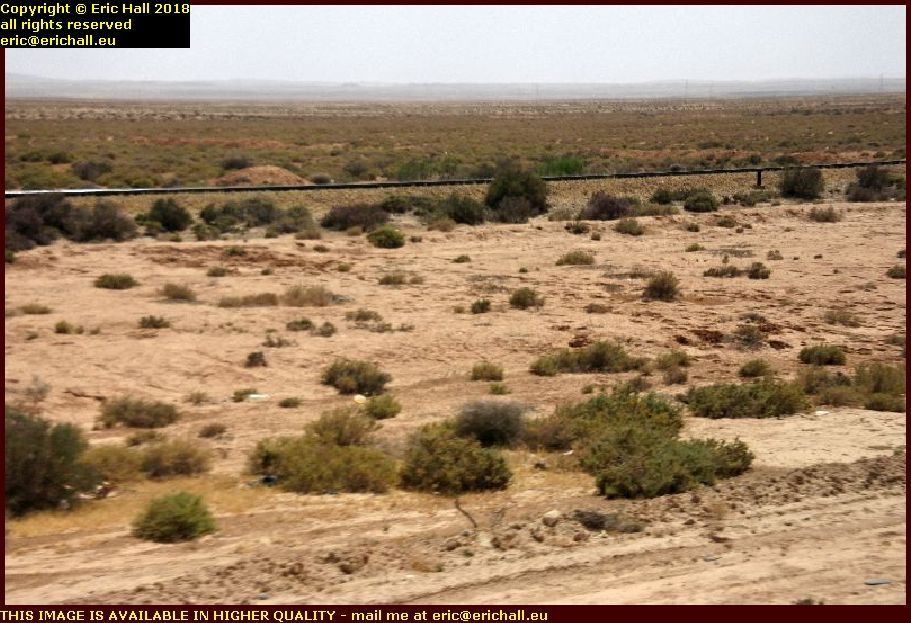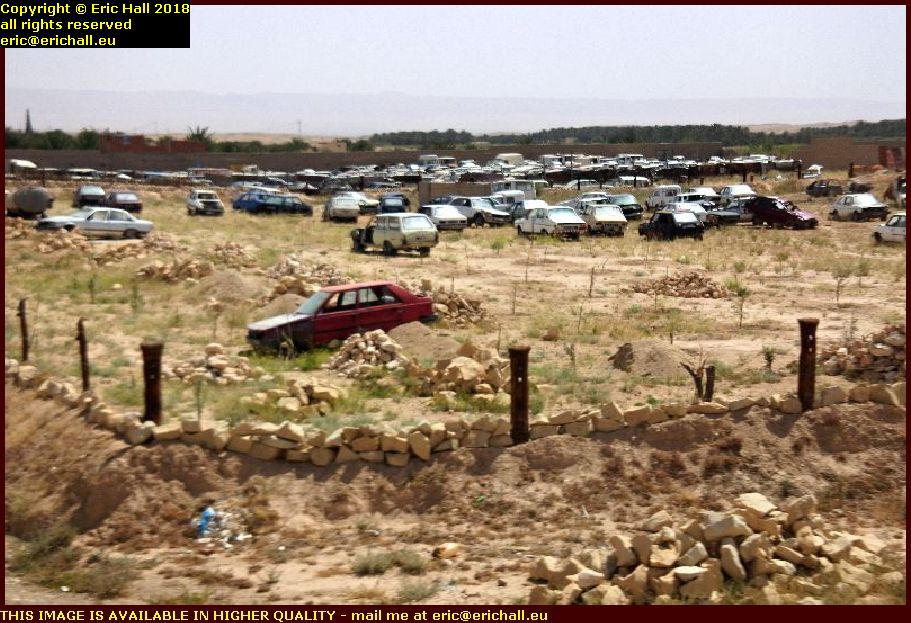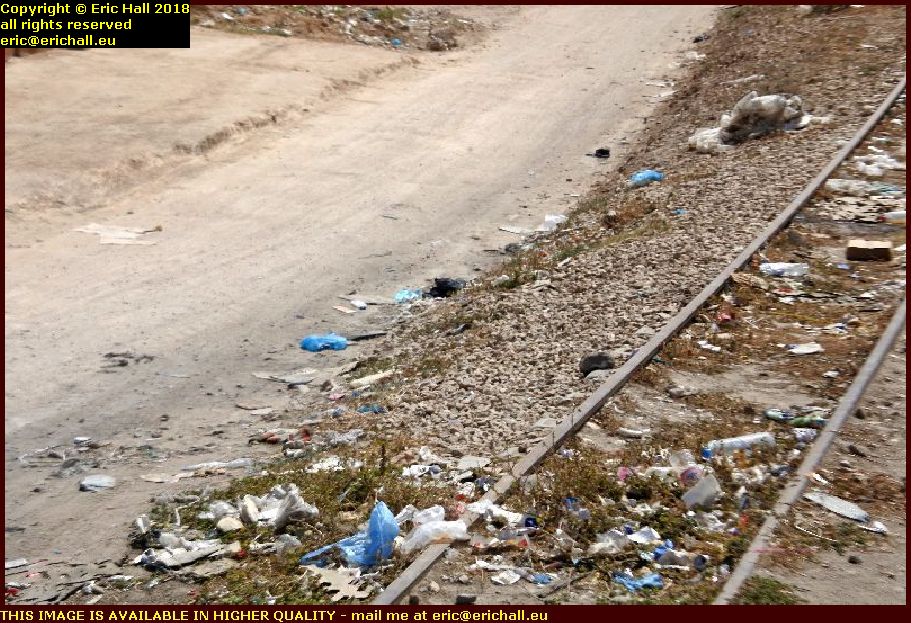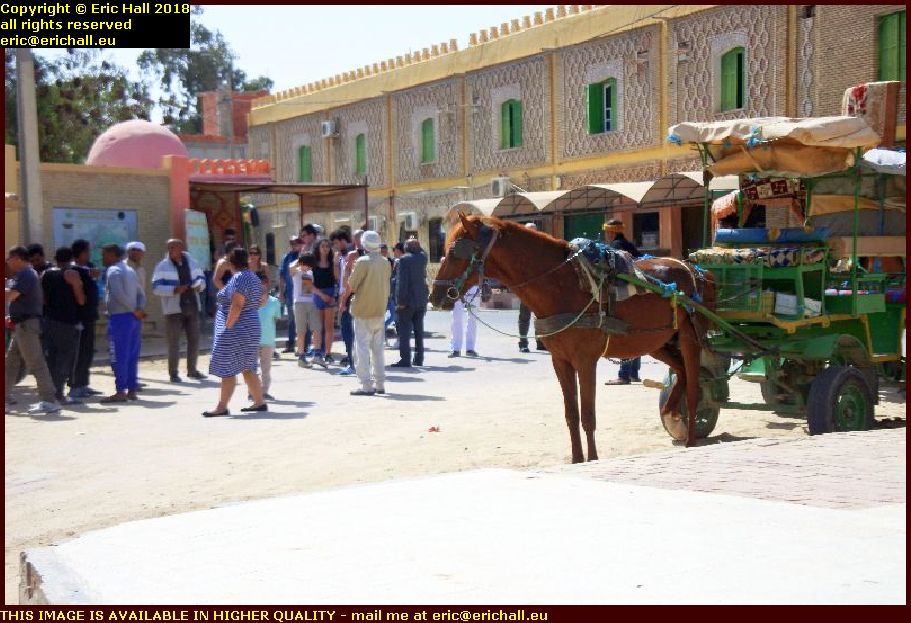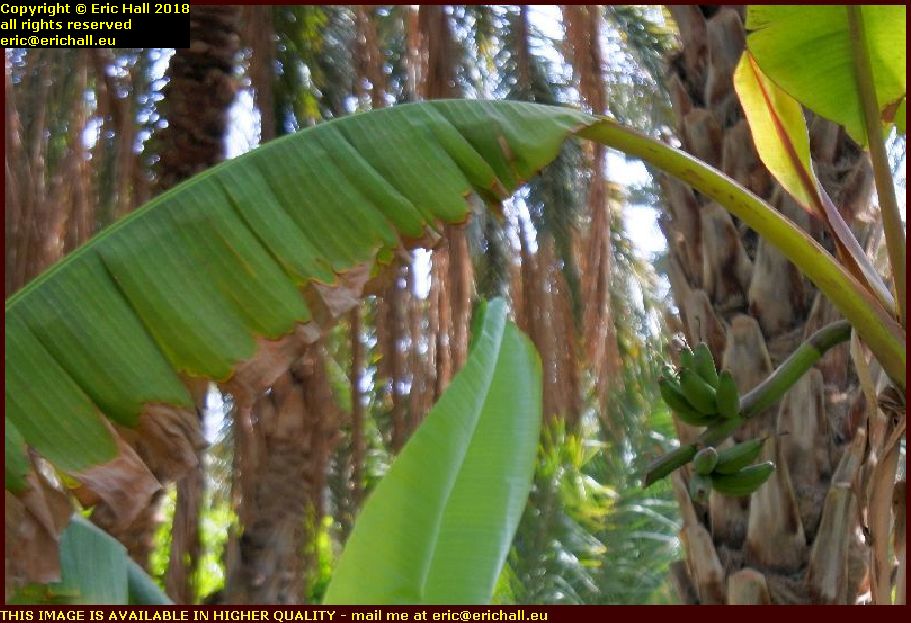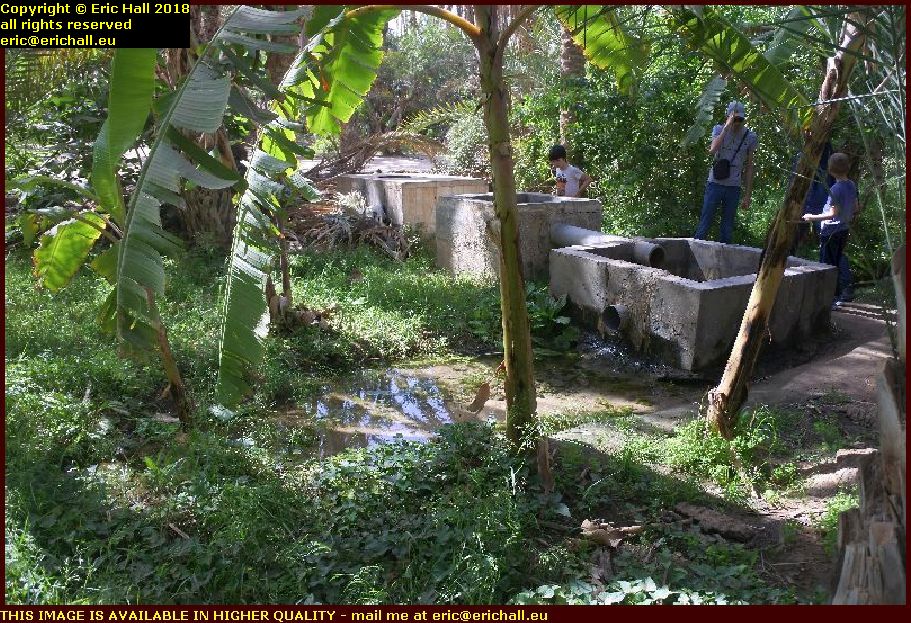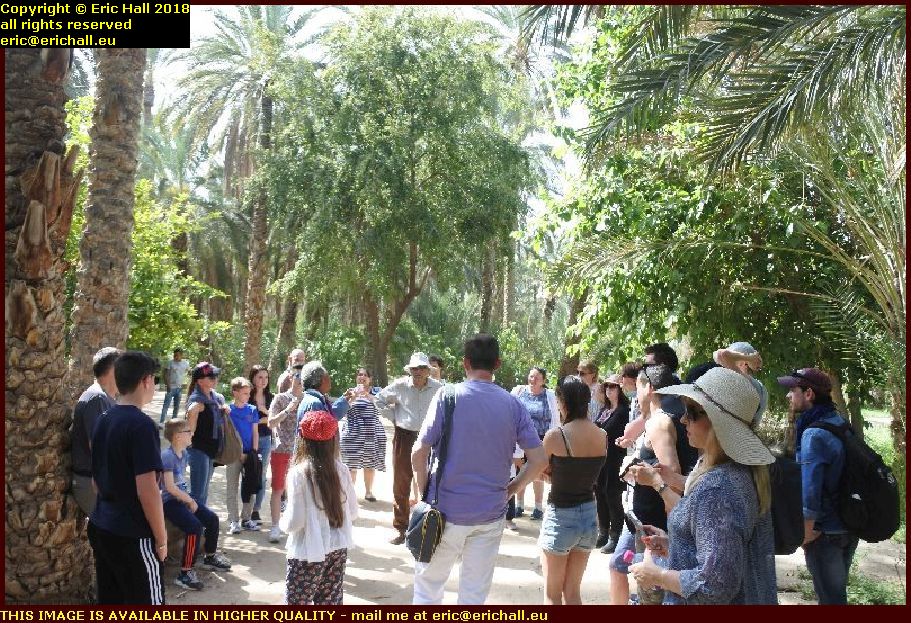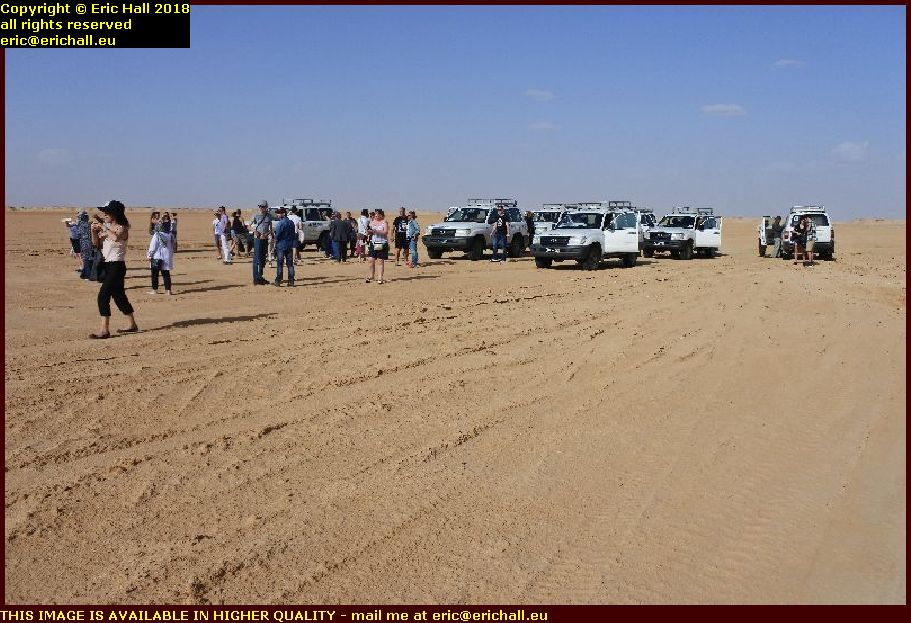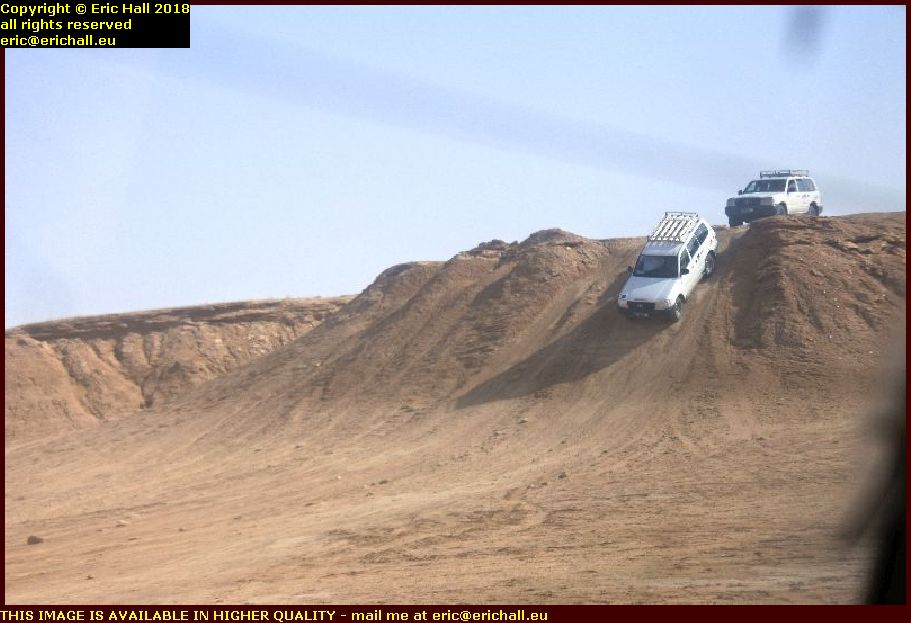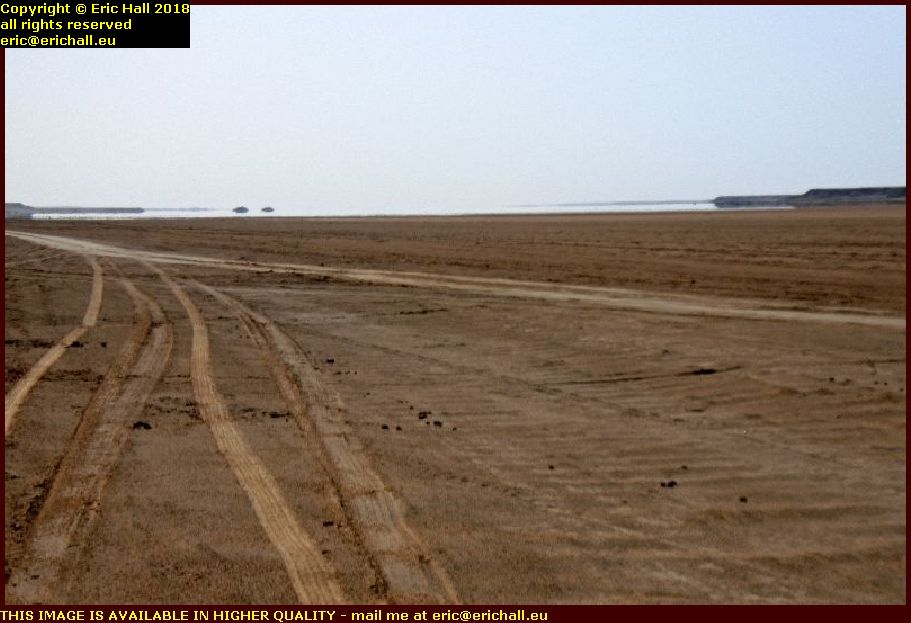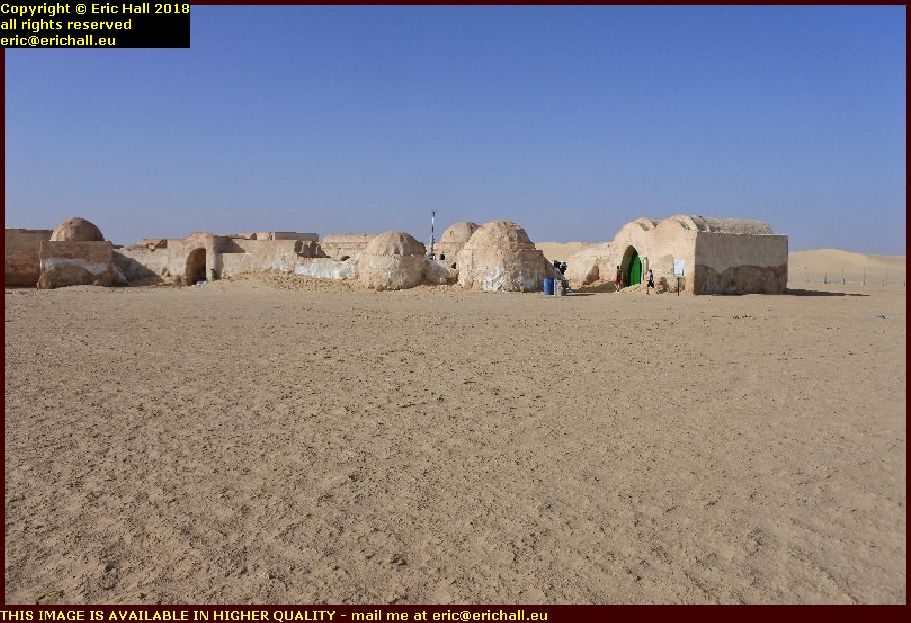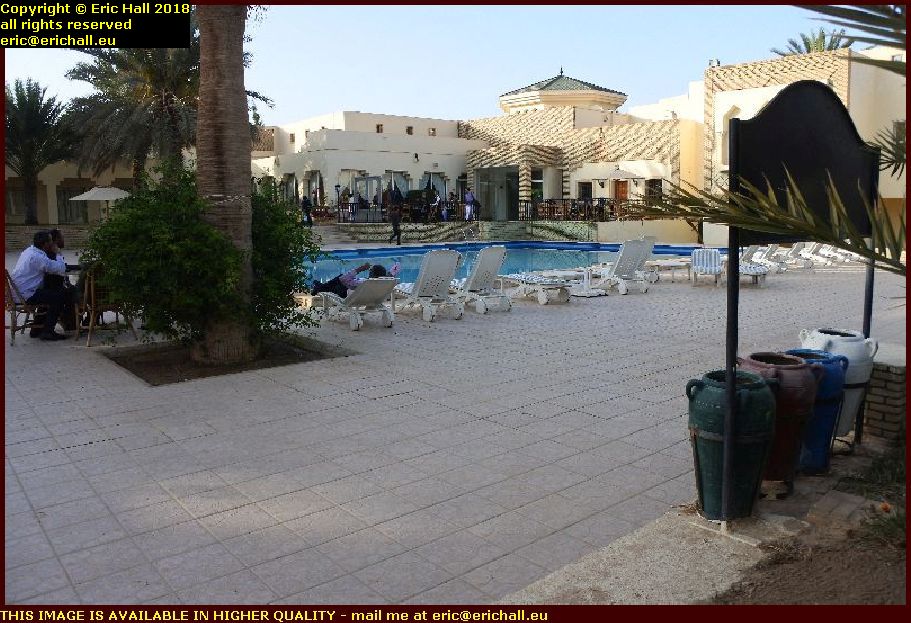… day.
My alarm went off at 03:55,followed by a ‘phone call at 04:00 to awaken me.
But I didn’t really need much awakening as, true to form, I had had a disturbed night – just as I usually do when I need to raise myself early.
But I’d still managed to go off on a really long ramble. However, I’m not going to tell you about it and you will thank me for that. You’re probably eating your tea or something.
So alarm at 04:00 and at 04:05 I was tucking in to breakfast. Not a big choice out here (no surprise there of course) and it didn’t take me long to eat. And then I was in my room preparing to depart.
 05:00 saw us all pile onto the bus and we set off from town to the Chott-el-Jérid, the big salt lake outside town, deep in the Sahara desert where we waited to see the sun come up.
05:00 saw us all pile onto the bus and we set off from town to the Chott-el-Jérid, the big salt lake outside town, deep in the Sahara desert where we waited to see the sun come up.
It was a little chilly at that time of the morning for those of us in just tee-shirts and there was a little breeze. Quite unexpected in the Desert you might think, but it’s a well-known phenomenon that has caught out many a traveller.
The sunrise itself was not as magnificent as watching the sun rise across the Bay of Piraeus in Greece back in 2013 but nevertheless, seeing the sun rise over the Sahara Desert has to be an experience and it was something that I wouldn’t have missed for the world.
 From here we drove on, deeper into the desert and eventually we arrived in the town of Douz – a town known from antiquity as “The Gateway To The Sahara”
From here we drove on, deeper into the desert and eventually we arrived in the town of Douz – a town known from antiquity as “The Gateway To The Sahara”
We weren’t actually stopping here, just passing through, but at least we went past the famous statue in the Place des Martyrs.
I’m not sure who the martyrs were, or why they were martyred, but there were certainly a few confrontations with Authority here a few years ago that ended up with a couple of people getting a 15-year holiday at the Government’s expense.
 While we admire the local scenery and the exciting artisanal works of art, let me tell you that had you had come here years ago you would have been amazed at all of the hustle and bustle in the streets.
While we admire the local scenery and the exciting artisanal works of art, let me tell you that had you had come here years ago you would have been amazed at all of the hustle and bustle in the streets.
That’s because Douz was a focal point of the camel trains that worked their way across the various routes of the desert bringing in just about everything from all corners of the World.
There’s still a huge market here, possibly the only relic of those glorious days of commerce, and had we come here on a Thursday, it would have been the market day for camels and donkeys.
And then I could have gone out on my ass.
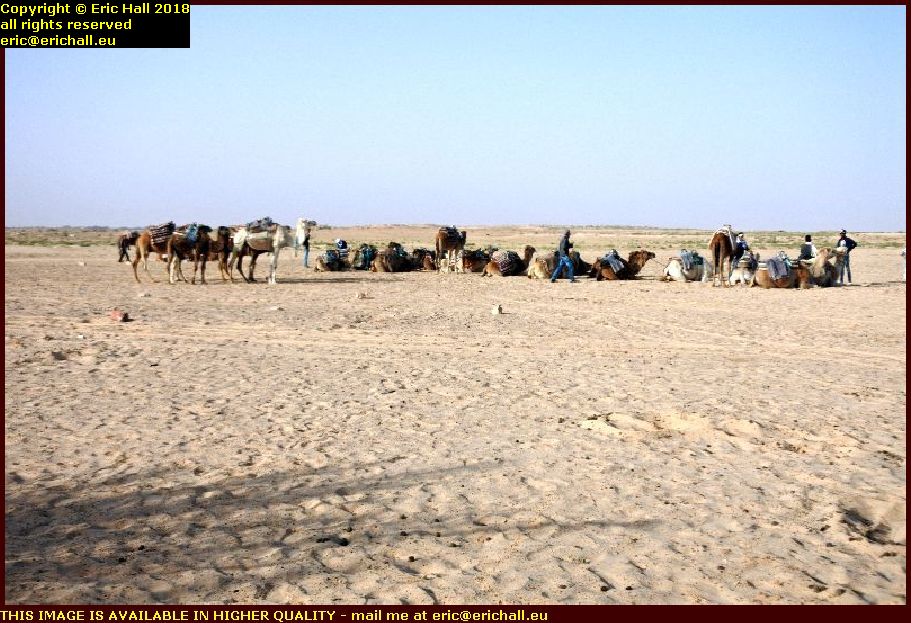 We stopped on the outskirts of the town for what was the highlight of the trip.
We stopped on the outskirts of the town for what was the highlight of the trip.
We were going to visit the Grand Erg – the Sea of Sand that covers the south-western quarter of Tunisia – a trek into the desert, and on a camel too.
That is to say – not all of us on one camel but on one camel each, which is probably just as well.
 And so having changed into native Touareg dress I leapt aboard my camel, which I named Sopwith, and I was off.
And so having changed into native Touareg dress I leapt aboard my camel, which I named Sopwith, and I was off.
But I got back on again and in company with about 30 others we headed for the interior. 07:00 is the best time to do this because it’s light but not hot, which I can perfectly understand.
Although if this wasn’t hot I don’t know what is and I’m glad that I wasn’t out there at 13:00
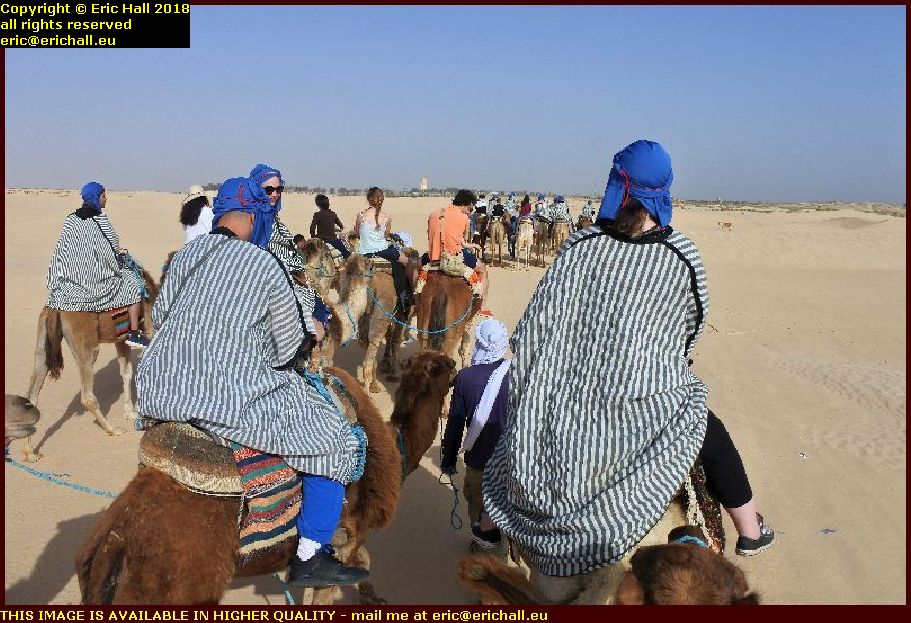 It was a bit of a disappointment in one sense because we were only out for an hour and a half or so.
It was a bit of a disappointment in one sense because we were only out for an hour and a half or so.
But on the other hand, I’m glad that it was only an hour and a half and not any longer because I don’t know how Lawrence of Arabia must have managed with four years on the back of a camel.
And now I understand completely just why John Wayne always walked like he did in all of his westerns
 But very bad planning here on my part.
But very bad planning here on my part.
One of our party, with a blonde-haired wife, was offered 26 camels for his wife. “Make it 30” he said “and she’s all yours”. And received a dig in the ribs.
Nevertheless, it made me think that I should have invited Nerina on this journey. I could have made myself a fortune here, particularly with the camel market in the town on a Thursday where I could have cashed out.
 And that wasn’t the only excitement either.
And that wasn’t the only excitement either.
See the horse ad rider over there on the right of this image? One girl of our party – a youngish blonde – was whisked off on the back of it and was galloped off into the distance at a rapid rate of knots.
“That’s the last we’ll see of her” we said. “She’ll wake up tomorrow morning someone’s harem, yashmak glittering in the breeze”.
And serve her right too
 Our route back to the camp took us past the site of where a previous tourist had told his guide that he wasn’t going to leave him a tip for his services.
Our route back to the camp took us past the site of where a previous tourist had told his guide that he wasn’t going to leave him a tip for his services.
And then we all dismounted (which pleased me greatly), handed back our Bedouin gear and boarded the bus. And let me tell you that getting on and off a camel is no mean feat either.
I made a quick little excursion back into the desert to grab some sand in a plastic bag that I had brought with me. I mean – it’s not every day that you get to go into the Sahara Desert.
 Back on the bus we set off for the coast.
Back on the bus we set off for the coast.
And I have seen some interesting vehicles on this voyage that you are never likely to see in Western Europe, like the motorcycle pick-up just here on the roundabout. Plenty of them wandering around in Tunisia and I can think of 100 uses for something like that down on my farm, not that I’ll ever be back there again but that’s another story.
And the silver-grey Renault. You probably won’t have seen one of those either, and I’ll talk about that in a bit.
 Our guide told us that we were going to go through the Atlas Mountains, but that’s somewhat stretching the truth.
Our guide told us that we were going to go through the Atlas Mountains, but that’s somewhat stretching the truth.
The Atlas Mountains finish just after the border with Algeria and in the north of the Country. The mountains that run down the middle of Tunisia here in the south are part of a chain called the Djebel Dahar.
They may not quite be the Atlas Mountains, but they are spectacular nevertheless.
 And it was around here in the foothills of the mountains that we encountered our first real tribes of nomadic Bedouins.
And it was around here in the foothills of the mountains that we encountered our first real tribes of nomadic Bedouins.
They are still living pretty much as their ancestors did in Biblical days, like this man here out on his ass checking on his herd of goats, sheep and camels would have done 2,000 years ago.
And there were plenty of them, nomads, sheep, goats and camels, trying their best to eke out an existence here in the desert. And It can’t be easy.
 As we climbed up into the mountains, at a certain point there was clearly some artificial terracing here where there was some kind of oasis or well.
As we climbed up into the mountains, at a certain point there was clearly some artificial terracing here where there was some kind of oasis or well.
I was sorely tempted to cry out “Romans” because if anything looked like a Roman vinyard terracing, then this would be it. Facing directly south into the sun.
There was a Roman town – Turris Tamalleni – in the vicinity where the Romans had installed some kind of artificial irrigation system, and vines were known to be an important crop from North Africa.
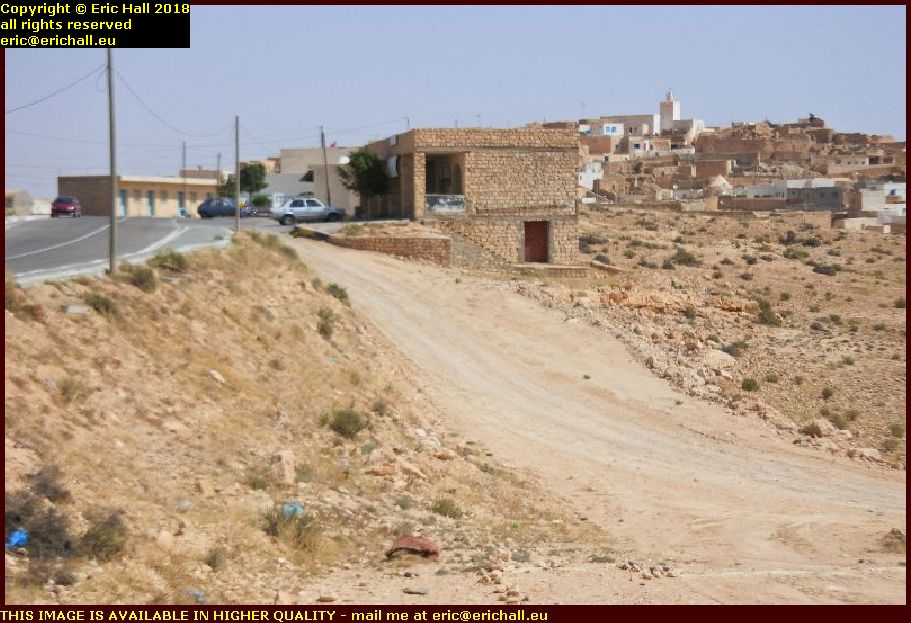 It was about 10:00 when we arrived on the edge of a small town called Tamezret.
It was about 10:00 when we arrived on the edge of a small town called Tamezret.
It’s a Berber village with about 500 people, only a fraction of the population that it would have had in the past as its importance as a caravan halt in the pass through the mountains has long-gone.
However, the village is heaving during the summer because it’s the custom for people who originated or who are descended from dwellers in the village to return here in the middle of August where there is some kind of homecoming festival.
One of the more famous emigrés from this region went to live in Spain, and he became so famous that the Italian compose Rossini wrote an Opera about him – “The Berber of Seville” … "are you sure about this?" – ed
 It has a special claim to fame too in that as well as the original Berber language still being spoken here too, the years are calculated by the original Berber calendar – not the Christian calendar and not the Muslim calendar either as you might otherwise have expected.
It has a special claim to fame too in that as well as the original Berber language still being spoken here too, the years are calculated by the original Berber calendar – not the Christian calendar and not the Muslim calendar either as you might otherwise have expected.
So accordingly we are now in the year 2968, and I bet that that’s confusing for some. Particularly considering that just now I mentioned something about going back in time 2,000 years.
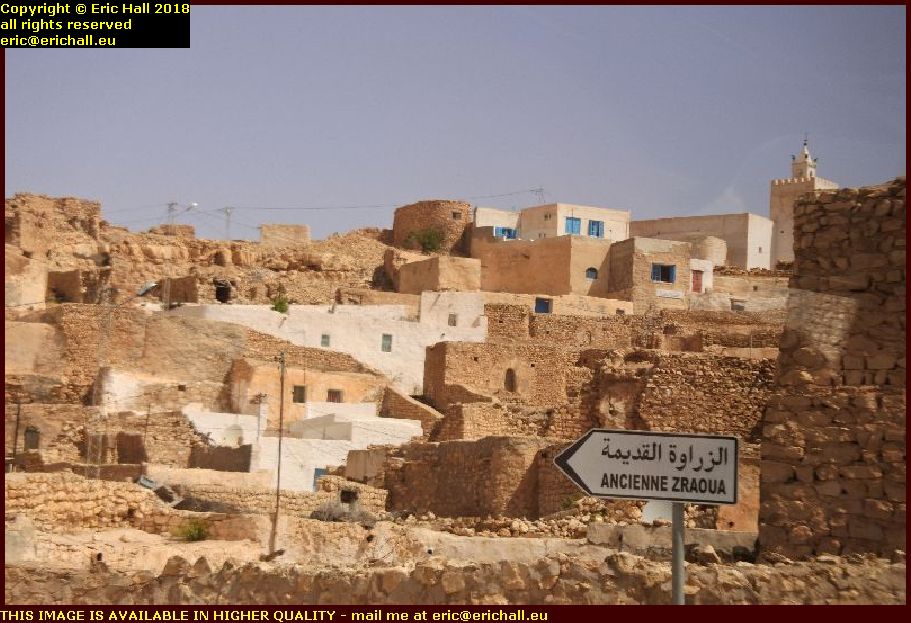 And how I would have loved to have found the time to have visited the ancient town of Zraoua.
And how I would have loved to have found the time to have visited the ancient town of Zraoua.
This was formerly one of the most important towns in the region but for one reason or other it’s practically deserted now. It has however survived quite well considering the events that have happened around here in the past, and has been used as the site of several French-language and Arab films.
But that will have to be for another day, if there is one.
 It might still be quite early but we had in fact been on the road for about 5 hours already and I for one was certainly ready to … errr … stetch my legs and have a coffee.
It might still be quite early but we had in fact been on the road for about 5 hours already and I for one was certainly ready to … errr … stetch my legs and have a coffee.
So we pulled up at a roadside place called Dar Ayed on the edge of town for a 15-minute pitstop and a good look around.
It’s actually a hotel, café and gift shop. And that’s hardly surprising because it is weren’t for the tourists there wouldn’t be anything here at all
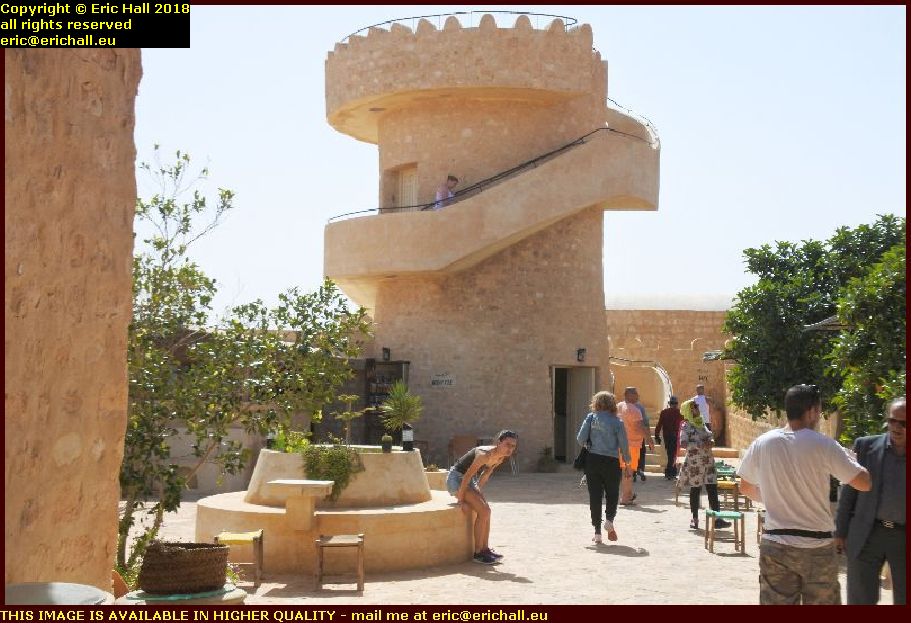 Dar Ayed has a claim to fame in that there’s a watch tower here that surveys the mountain passes that lead to here from the west and the south.
Dar Ayed has a claim to fame in that there’s a watch tower here that surveys the mountain passes that lead to here from the west and the south.
It’s a magnificent building, and if it’s the original (which somehow I doubt very much) it’s been superbly maintained and restored.
One of those places where we … "well, one of us" – ed … have to climb up to the top for a good look around
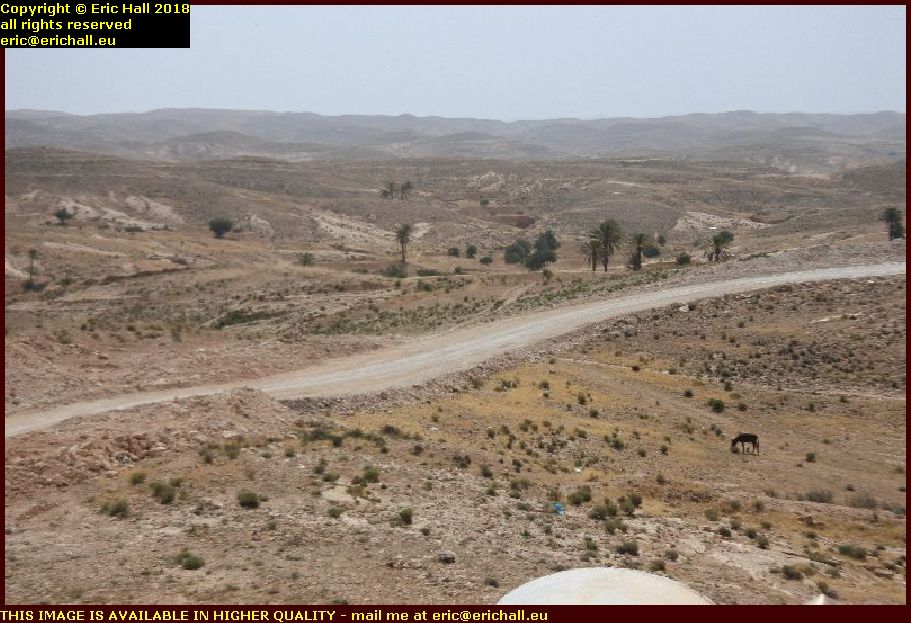 In the past, being a Berber was not a healthy lifestyle choice, with the Arab invasion from the east of the 8th Century and pressure from the other nomadic tribes from the West.
In the past, being a Berber was not a healthy lifestyle choice, with the Arab invasion from the east of the 8th Century and pressure from the other nomadic tribes from the West.
A good look-out was thus clearly important and no-one can complain about the view from here. You could spot from miles away people coming to Tamazret from the south and you would have plenty of time to organise your defences or call the people in from the fields.
 If you look over there, you’ll see the road by which we arrived at Tamezret.
If you look over there, you’ll see the road by which we arrived at Tamezret.
It came through the pass there to the west and you can see the road winding away in the distance towards Douz and Tozeur. Plenty of opportunity for someone up here to spot groups of travellers heading from the interior.
I suppose that these days the guy in the watchtower shouts down when he sees a tourist coach in the distance, giving the people in the kitchens plenty of time to throw another dozen burgers onto the barbie.
And do you like to solar water heater on the roof? There are also some solar panels. Things are looking up.
 THis area is quite well-known for its cliff-dwellings. Not like the Pueblo cliff-dwellings of New Mexico, but cliff dwellings nevertheless.
THis area is quite well-known for its cliff-dwellings. Not like the Pueblo cliff-dwellings of New Mexico, but cliff dwellings nevertheless.
The cynic inside me suggested that the tourist guide on our bus had his grandfather living in a cliff dwelling around here because he took us to see one near Matmata where there was a Berber still in residence.
And for a dinar, of which there are about three to the Euro, we could go in for a look around.
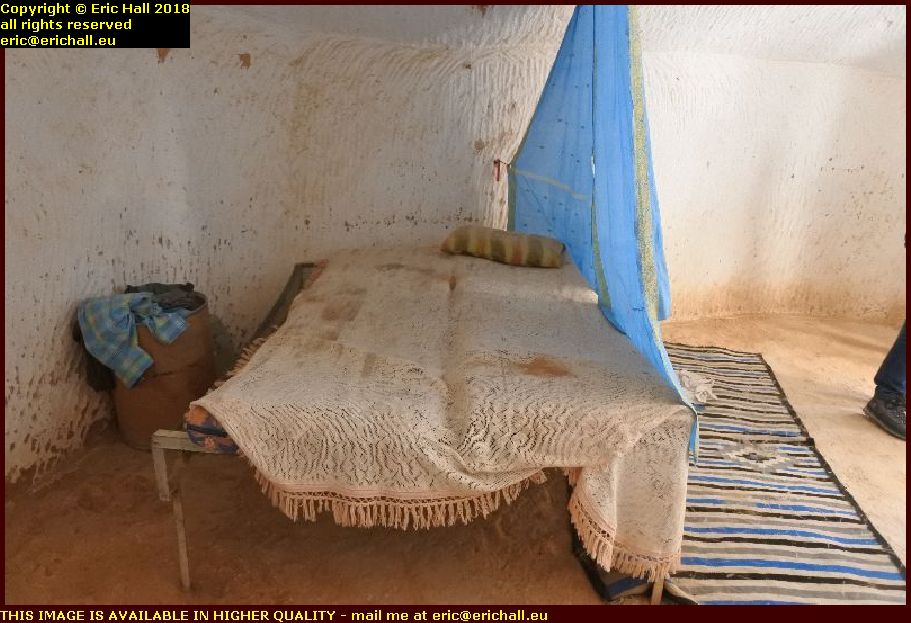 33 cents isn’t expensive by any means, and I’ve paid much more money than that to see some even worse ruins.
33 cents isn’t expensive by any means, and I’ve paid much more money than that to see some even worse ruins.
And what was pleasantly surprising was just how cool it was inside. Apparently the temperature inside the cliff is pretty constant summer and winter and it’s very rare that you need any heating.
And this comes as a total surprise to people who have moved out of the cliff dwellings into more modern accommodation where you need air-conditioning in the summer and heating in the winter.
 The palm tree and the fig tree (or is there a date tree) are quite interesting.
The palm tree and the fig tree (or is there a date tree) are quite interesting.
The ground isn’t level here, it’s all on something of a slope and so when there’s a rainstorm (which there is occasionally) all of the water that falls on the property runs down to that bottom corner.
And so his little orchard is to all intents and purposes self-watering.
 By now my stomach was thinking that my throat had been cut, so it was just as well that our guide announced that it was lunchtime.
By now my stomach was thinking that my throat had been cut, so it was just as well that our guide announced that it was lunchtime.
We ended up at a hotel on the edge of Matmata where a meal had been arranged for us. And our arrival had been clearly awaited by others too because there were yet more of these youths with their scrawny misshapen animals expecting you to want to have your photo taken with them – at a fee of course.
One poor girl had some boy place some kind of vulture on her shoulder while her attention was elsewhere, and you could have heard the scream back on the coast.
 The Hotel Matmata had clearly seen better days, but I’ve stayed in worse places in western Europe than here.
The Hotel Matmata had clearly seen better days, but I’ve stayed in worse places in western Europe than here.
In any case, we were only going to eat here. Couscous and vegetables and I traded my chicken for someone else’s helping of bread so I was quite happy with that.
And fresh fruit for pudding too. Just like being back at home, except that the fresh fruit really was fresh.
 At Matmata we are effectively at the watershed of the Djebel Dahar mountains. And so just around the corner as you leave the town there is probably one of the most stunning views in the whole of North Africa.
At Matmata we are effectively at the watershed of the Djebel Dahar mountains. And so just around the corner as you leave the town there is probably one of the most stunning views in the whole of North Africa.
It’s one of the best views that I have seen in recent times. We are probably about 50kms from the coast at this spot and I reckon that on a clear day with no haze you would be able to see it too.
As you know, Jersey is 54 kms from Granville and I can see it with my naked eye from a height of 60 metres, never mind 600 metres.
 And if you remember the terracing that we saw a short while ago which I reckoned was Roman, we might have to think again.
And if you remember the terracing that we saw a short while ago which I reckoned was Roman, we might have to think again.
There are rows and rows of similar terraces just here too, but these are facing northwards so very unlikely to be vines.
Speaking to the tour guide, he reckons that they are avalanche walls, to protect people passing down the valley (before the road was built) from falling stones. Mind you, that’s a lot of effort.
Remember the silver-grey Renault that we saw in Douz, and I said that we would say something about it later?
 That’s because just here I found an example parked right where I could take a photograph of it.
That’s because just here I found an example parked right where I could take a photograph of it.
It’s a Renault Symbol, and as I said, I bet that you haven’t seen one of these before.
The story goes that Renault introduced the new generation Clio in 1999 as a car for the world market, but while it sold very well in some markets, it bombed in others.
Subsequent enquiries revealed that many countries in the world aren’t too keen on hatchbacks, but prefer a proper “three-box” design. Renault dealt with the matter by taking a Clio, sticking a boot on it, and calling it the Symbol. It’s only offered for sale in North Africa, certain countries in Eastern Europe and the Middle East.
 We had a pretty uneventful drive down the hill all the way to the coastal strip, and here we encountered our first clue that we are near the Libyan border.
We had a pretty uneventful drive down the hill all the way to the coastal strip, and here we encountered our first clue that we are near the Libyan border.
Tripoli is a city, and the capital of a province in Libya and being so close I would have liked to have gone for a wander down the road in that direction but there was an army checkpoint further down the road, so maybe not this time.
However I was quite intrigued by the Mercedes in the photograph. It’s carrying a German “export” numberplate. I’d seen several vehicles over here with European numberplates and I was wondering how they arrived here. I wonder if Caliburn fancies a trip out some day soon.
Incidentally, where we are is not very far from what is known as “The Mareth Line” – the version of the Maginot Line that was built here to protect the French colony of Tunisia from invasion by the Italians in Libya at the start of World War II, and later heavily defended by Rommel and the Afrika Corps against the 8th Army.
 On the outskirts of Gabès we came across the railway line – the metric-gauge line that links the town with Tunis and also the phosphate mines in the interior.
On the outskirts of Gabès we came across the railway line – the metric-gauge line that links the town with Tunis and also the phosphate mines in the interior.
There are a couple of nice locomotives there too It’s difficult to identify them as trying to take a photo with a telephoto lens while passing over a level crossing is not easy. But the front one may well be a Bombardier MX624 and the rear one could be any one of three or four different classes of General Electric machine.
Nice to see one of my former employers doing the business here.
 Now here’s an interesting photograph. This is not a Tunisian petrol station, but on the other hand it is.
Now here’s an interesting photograph. This is not a Tunisian petrol station, but on the other hand it is.
Tunisia has its own oilfields, but very little capacity for refining. So almost all of its oil is exported abroad in crude form. The country then imports refined petrol and diesel from other African countries.
But with the various difficulties that the country is facing, the country is obliged to import the cheapest fuel that it can find on the open market and that fuel, to put it frankly, is rubbish,
Being so close to the the Libyan border where we are, where the fuel is of first-class quality, there’s a huge black market in Libyan (and Algerian) fuel. And it shows you just how tenuous the Government’s control of the southern part of the country is when you see the fuel sold openly on the side of the road like this.
 We made it as far as Mahres before the urge to stop for a coffee overwhelmed us.
We made it as far as Mahres before the urge to stop for a coffee overwhelmed us.
While the others rested in the shade of a roadside café I took my coffee outside and went for a wander on the beach.
It’s not exactly what you would call a major tourist attraction here, being somewhat off the beaten track, but it was quite interesting nevertheless.
 THat’s not to say though that the place isn’t popular. It’s another one of these towns to where in the summer the emigrés will return and then the beaches will be heaving with people.
THat’s not to say though that the place isn’t popular. It’s another one of these towns to where in the summer the emigrés will return and then the beaches will be heaving with people.
I think that what puts off the westerners from coming here is the fish port and the fish processing. That’s a comparatively new, or maybe I should say modern phenomenon, having been opened in 1987.
There’s a big natural gas plant up the road too which doesn’t help.
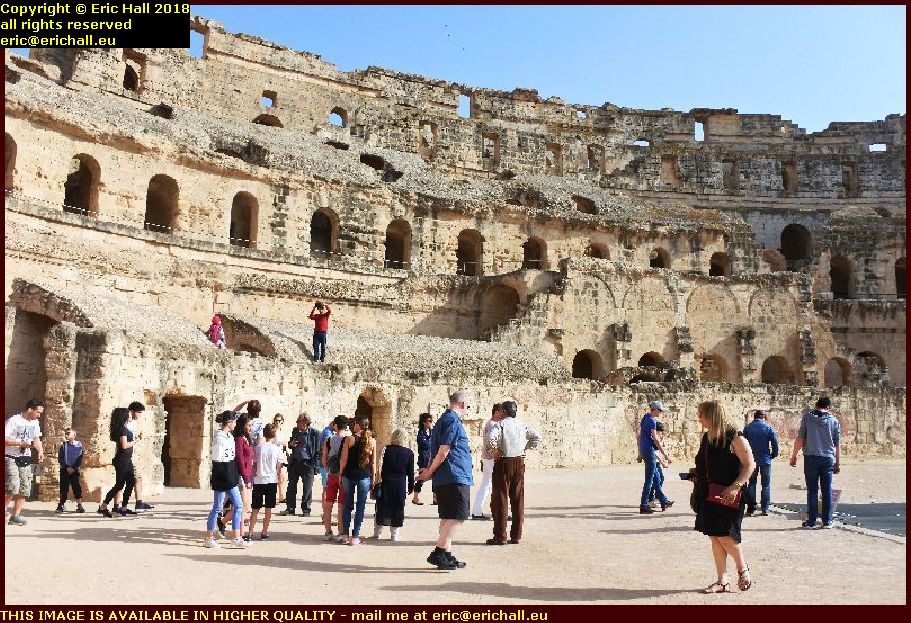 Now, hands up if you know where this is.
Now, hands up if you know where this is.
I mean – you might not actually know where it is, but I bet that you have all seen it at some time or other.
And where you will have seen it is firstly in the film Gladiator starring Russell Crowe. It’s in here that the climax of the film takes place.
 You’ll recognise the view right down there at the bottom of the steps too.
You’ll recognise the view right down there at the bottom of the steps too.
That’s where the Popular Front of Judea was sitting in Life of Brian because the amphitheatre scenes in that film were filmed in here too.
And so it’s all of this that makes it probably the best-known of all of the Roman amphitheatres
 Where we are is in the town of El Djem, better-known as the Roman town of Thysdrus and home of what many people consider to be the most remarkable and most intact of the amphitheatres of the Roman Empire
Where we are is in the town of El Djem, better-known as the Roman town of Thysdrus and home of what many people consider to be the most remarkable and most intact of the amphitheatres of the Roman Empire
You need to remember that back in Roman times this area was much more humid than it is now and the coasts of North Africa supplied the greater part of the agricultural produce consumed by Rome.
Thysdrus was the centre of olive oil production for the Roman Empire. As a result, it was a very propsperous area and the remains of the many Roman villas that have been discovered in the vicinity bear this out.
 The city was one of the three most important cities in Roman North Africa and consequently the population was to be favoured when it came to issues of recreation.
The city was one of the three most important cities in Roman North Africa and consequently the population was to be favoured when it came to issues of recreation.
The Amphitheatre, with a capacity of 35,000 spectators, making it possibly the 3rd largest in the Empire, was built on the orders of the Proconsul Gordian before his (very brief) reign as Emperor in The Year Of The Six Emperors.
It is said to have replaced an earlier Amphitheatre and while no remains of such an earlier one have been found, aerial photography seems to suggest that a stadium corresponding to the type that was used for horse racing may well have been situated on the outskirts of the town.
 As for “Gladiator”, regardless of any historical accuracy Russell Crowe would have felt quite at home here because that type of fight often took place in the amphitheatre.
As for “Gladiator”, regardless of any historical accuracy Russell Crowe would have felt quite at home here because that type of fight often took place in the amphitheatre.
Another person who would have been quite at home here was Charlton Athletic, for the kind of chariot races in which he participated in Ben-Hur took place here too.
Although if they made the film today they would have to call it “Ben Them” of course.
 And of course we had Christians being thrown to the lions too. Whenever that took place, the trench in the middle of the floor was covered over with woden planks (the metal grille is a recent innovation) so that the Christians couldn’t escape by jumping into the cellar.
And of course we had Christians being thrown to the lions too. Whenever that took place, the trench in the middle of the floor was covered over with woden planks (the metal grille is a recent innovation) so that the Christians couldn’t escape by jumping into the cellar.
On the other hand, when there was a gladiator fight, the trench was left uncovered with the lions roaming about freely down below,
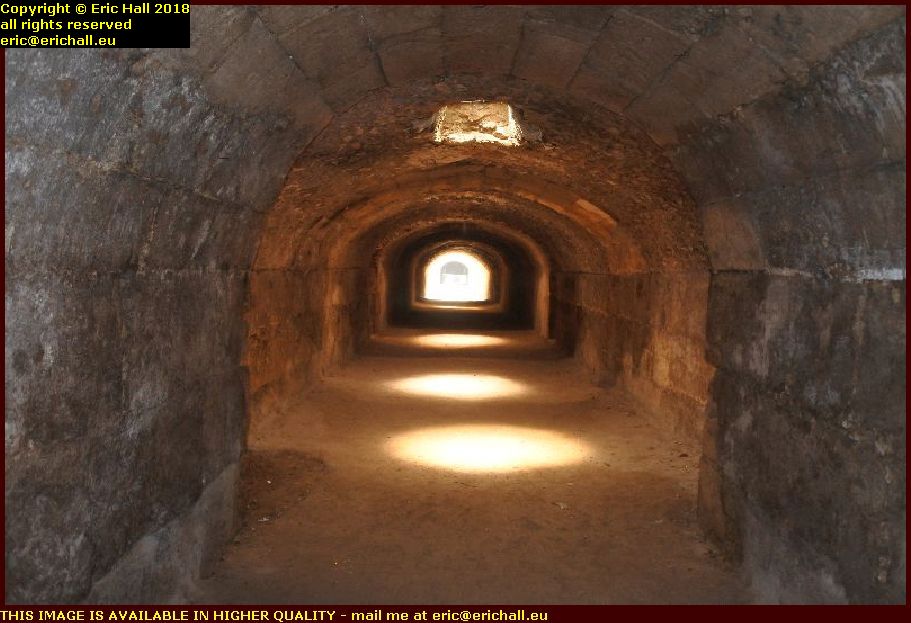 The object of the Gladiator fight was, if not to kill your opponent, to knock him down into the cellar where the lions would take care of him.
The object of the Gladiator fight was, if not to kill your opponent, to knock him down into the cellar where the lions would take care of him.
The lions were kept in cages down below and there was a marvellous story once told that a group of people was invited to witness a spectacle here but because there was no other accommodation for them, they were told that there would be some space for them in the cages of the lions.
Of course, after the lions had been removed. But I bet that they worried all the same.
 The amphitheatre was designed to be four storeys high but there is some dispute about whether it was actually completed.
The amphitheatre was designed to be four storeys high but there is some dispute about whether it was actually completed.
It’s known that work stopped here earlier than expected after the troops of Capelianus of Numidia overthrew Gordian and his supporters after a reign of just 21 days – told Gordian to get knotted probably, and that the amphitheatre has been badly damaged on several subsequent occasions, but whether or not it reached the full four storeys in that corner cannot be definitely confirmed.
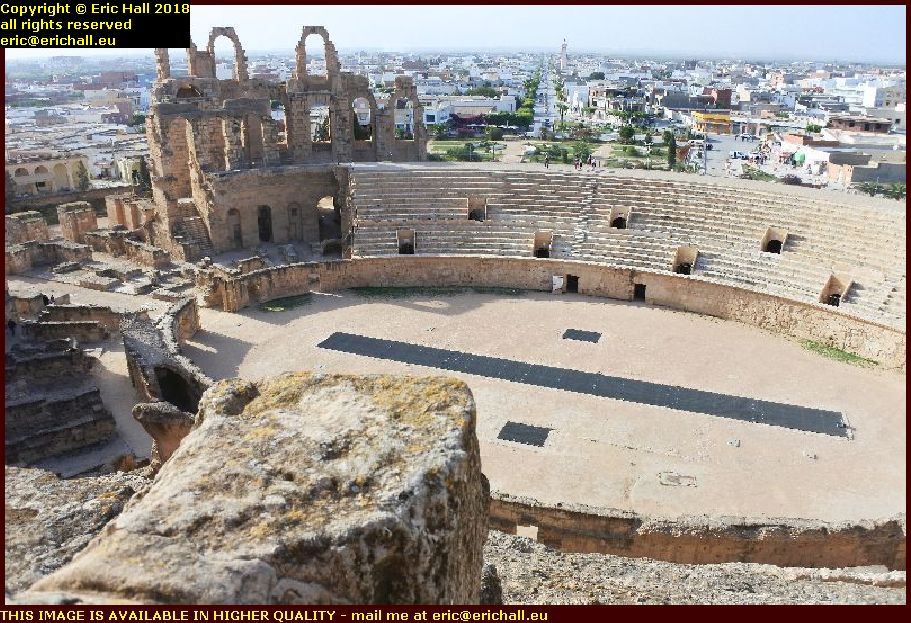 The reasons for the destruction of that side of the amphitheatre are threefold
The reasons for the destruction of that side of the amphitheatre are threefold
- It was used as a fortress by the locals to defend themselves against the Arab invaders in the 8th Century and was damaged when the latter stormed it
- It was likewise used when the Ottomans came here in on several occasions as fighting swept back and forth across the coastal plain in the 16th Century, and on one occasion cannons were used against it.
- After the final capture of the amphitheatre at the beginning of the 17th Century it was pillaged for stone to build the city and the Great Mosque at Kairouan
 It was declared a UNESCO World Heritage Site in 1979 and quite rightly so because it’s the most astonishing surviving historical object on the whole coast of North Africa if you ask me.
It was declared a UNESCO World Heritage Site in 1979 and quite rightly so because it’s the most astonishing surviving historical object on the whole coast of North Africa if you ask me.
I was really glad that I had had the opportunity to come here., even if we did only have about an hour to explore the amphitheatre. I could quite easily have spent all day here.
But that’s the problem when you travel in a group like this. You are tied to other people’s arrangements.
 Despite the limited amount of time and my own little health issues, I made it right the way up to the very top of the amphitheatre and was able to look down on the crowds in the street.
Despite the limited amount of time and my own little health issues, I made it right the way up to the very top of the amphitheatre and was able to look down on the crowds in the street.
Tunisia had just qualified for the World Cup or won a football match or something, and there were crowds in the streets and in cars sounding their horns and waving flags about.
And why not? It doesn’t happen every day, at least over here.
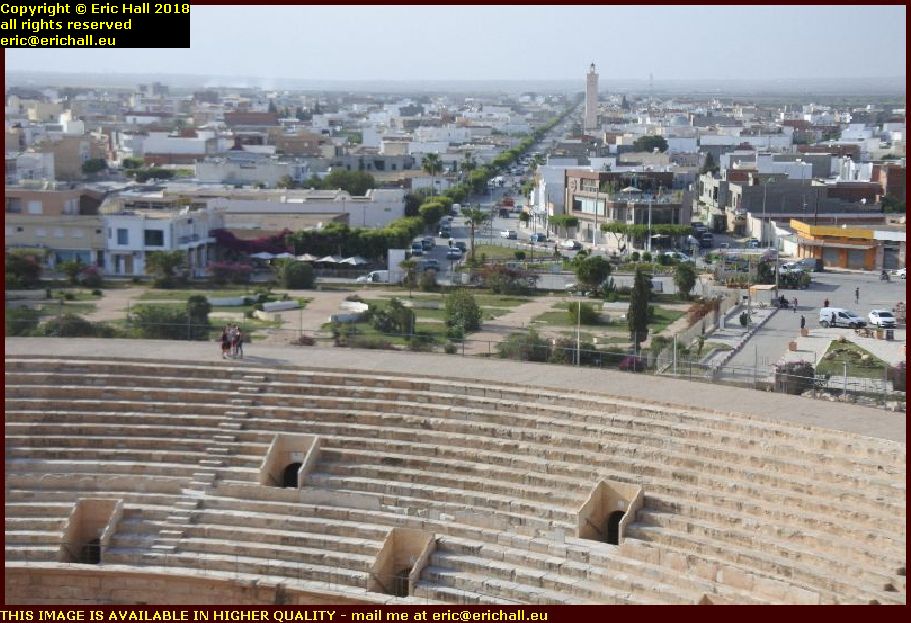 And I’m glad that I made it right to the top, because the view from up here really is excellent.
And I’m glad that I made it right to the top, because the view from up here really is excellent.
It’s a shame that there’s so much haze because the view of the mountains over which we have just driven must have benn spectacular.
What’s also spectacular is how they have managed to maintain so much of the grid pattern of streets. But whether this is a Roman influence or some other influence I really couldn’t say.
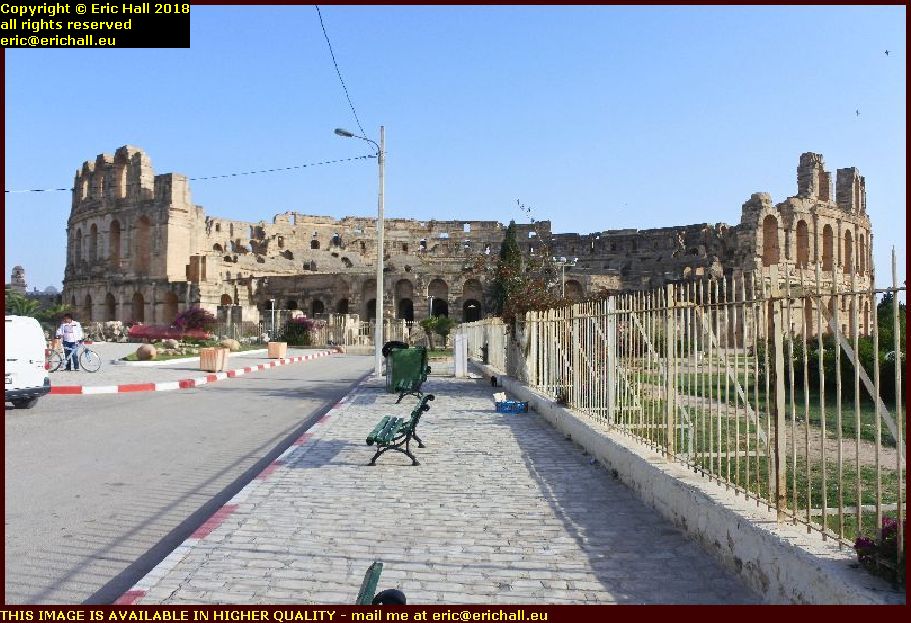 Leaving the amphitheatre later I noticed that the sun had finally moved round so that I could take a photo of it.
Leaving the amphitheatre later I noticed that the sun had finally moved round so that I could take a photo of it.
It’s rather disapointing when there’s only one really good viewpoint and the sun is streaming full-on into the lens.
And while I was taking this photo an old bright yellow Motobécane moped went past, still with the otiginal yellow and blue “La Poste” stickers. I bet that he didn’t ride that all the way from France.
Back on the road again heading for home. I make it 12.5 hours that we’ve been on the road already and there’s still a long way to go.
 And amongst the things for which I’ve been keeping an eye out are old or unusual vehicles.
And amongst the things for which I’ve been keeping an eye out are old or unusual vehicles.
And while this lorry here, which I reckon might be a very early FIAT IVECO or very late FIAT OM, might not be quite so interesting, the cab in the middle is, I reckon a cab off an old OM lorry from the 50s or early 60s
And that makes it quite interesting.
By now I’d settled down to doze in my seat as we headed northwards. We successfully dodged the Police speed traps (although some motorist in front of us didn’t) and eventually those of us from the Sousse area were thrown out into the bus that was to take us back to our hotels.
And I can see now why it was so late in arriving yesterday morning. It took hours to negotiate the traffic around the various hotels all around Sousse. But I had an opportunity while we were stuck in various traffic queues to admire the shipping in the harbour. I shall have to come back.
I was thoroughly exhausted by the time I returned. It was a good job that there was still some food left, even if I did struggle to eat my tea (I was starving but also very tired), forgot my jacket in the restaurant and came back up here where I crashed out completely.
It’s a long time since I’ve been this tired.
And here’s 4641 words to keep you out of mischief. you lucky people. While you read it, I’m going to go to sleep.
